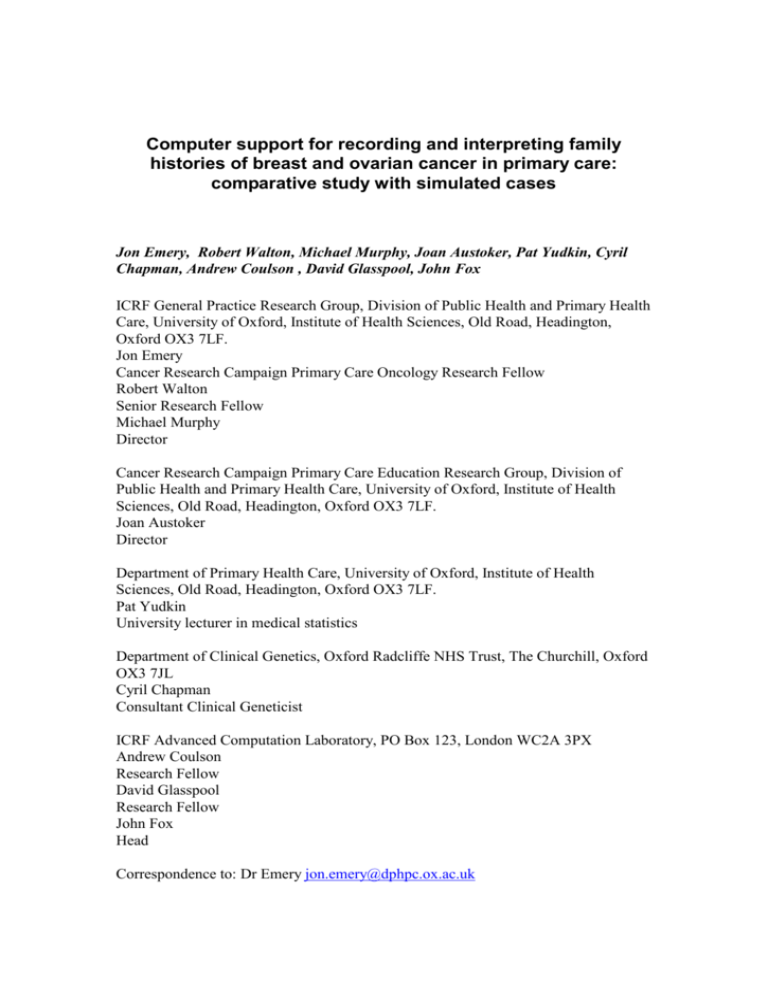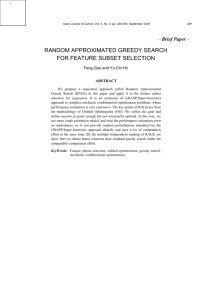Computer support for recording and interpreting family histories of
advertisement

Computer support for recording and interpreting family histories of breast and ovarian cancer in primary care: comparative study with simulated cases Jon Emery, Robert Walton, Michael Murphy, Joan Austoker, Pat Yudkin, Cyril Chapman, Andrew Coulson , David Glasspool, John Fox ICRF General Practice Research Group, Division of Public Health and Primary Health Care, University of Oxford, Institute of Health Sciences, Old Road, Headington, Oxford OX3 7LF. Jon Emery Cancer Research Campaign Primary Care Oncology Research Fellow Robert Walton Senior Research Fellow Michael Murphy Director Cancer Research Campaign Primary Care Education Research Group, Division of Public Health and Primary Health Care, University of Oxford, Institute of Health Sciences, Old Road, Headington, Oxford OX3 7LF. Joan Austoker Director Department of Primary Health Care, University of Oxford, Institute of Health Sciences, Old Road, Headington, Oxford OX3 7LF. Pat Yudkin University lecturer in medical statistics Department of Clinical Genetics, Oxford Radcliffe NHS Trust, The Churchill, Oxford OX3 7JL Cyril Chapman Consultant Clinical Geneticist ICRF Advanced Computation Laboratory, PO Box 123, London WC2A 3PX Andrew Coulson Research Fellow David Glasspool Research Fellow John Fox Head Correspondence to: Dr Emery jon.emery@dphpc.ox.ac.uk Abstract Objectives: To evaluate the potential effect of computer support on general practitioners’ management of familial breast and ovarian cancer, and to compare the effectiveness of two different types of computer program. Design: Crossover Subjects: experiment with balanced block design. A random sample of 100 general practitioners from Buckinghamshire were invited, of whom 41 agreed to participate. From these thirty-six doctors required for a fully balanced study were selected. Interventions: A computerised decision support system (Risk Assessment in Genetics- RAGs) was constructed using PROforma technology. Doctors managed 18 simulated cases, 6 with RAGs, 6 with Cyrillic (an established pedigree drawing program designed for clinical geneticists), and 6 with pen-and-paper. Main outcome measures: The number of appropriate management decisions made (maximum 6); the mean time taken to reach a decision; the number of pedigrees accurately drawn (maximum 6). Secondary measures were: method of support preferred for particular aspects of managing family histories of cancer; the importance of specific functions and information on cancer genetics that might be provided by an ‘ideal computer program’. Results: RAGs resulted in significantly more appropriate management decisions (median 6) than both Cyrillic (median 3) and pen-and-paper (median 3); median difference between RAGs and Cyrillic 2.5 (95% CI 2.0-3.0; p<0.0001). RAGs also resulted in significantly more accurate pedigrees (median 5) than both Cyrillic (median 3.5) and pen-and-paper (median 2); median difference in pedigree score between RAGs and Cyrillic 1.5 (95% CI 1.0-2.0 p<0.0001). The time taken to use RAGs (median 178 seconds) was 51 seconds more per case (95% CI 36-65; p<0.0001) than pen-and-paper (median 124 seconds) but was less than Cyrillic (median 203 seconds; difference 23; 95% CI 5-43; p=0.02) Thirty-three doctors (92%, 95% CI 78-98%) preferred using RAGs overall. The most important elements of an ‘ideal computer program’ for genetic advice in primary care were: referral advice; the capacity to create pedigrees; the ability to provide evidence and explanations to support advice. Conclusions: RAGs could enable general practitioners to be more effective gatekeepers to genetic services, empowering them to reassure the majority of patients with a family history of breast and ovarian cancer who are not at increased genetic risk. Word count: 2236 Key messages What is already known on this topic General practitioners will play an increasing role in providing genetic advice but currently lack the skills to be effective gatekeepers to genetics services Computers have been proposed as a way of supporting primary care in this new task What this study adds RAGs, a program designed specifically for primary care, resulted in more appropriate management decisions and more accurate pedigrees than both Cyrillic, an established pedigree drawing program designed for clinical geneticists, and traditional methods, but took an extra 51 seconds per case For general practitioners RAGs was superior to Cyrillic because it provided more relevant information and had a simpler interface Computer support could empower general practitioners to reassure patients with a family history of breast or ovarian cancer who are not at increased genetic risk and avoid unnecessary referrals This week in the BMJ Computer support could enable general practitioners to give their patients high quality advice about their genetic risk of breast and ovarian cancer. On page x Emery et al report a study, using simulated cases, comparing traditional pen-and-paper methods with two different computer programs: RAGs, a program designed for primary care, and Cyrillic, an established pedigree drawing program designed for clinical geneticists. RAGs resulted in more appropriate management and more accurate pedigrees than both Cyrillic and traditional methods. This study demonstrates the importance of developing software that is appropriate for primary care, and shows the potential of computer support to help general practitioners be more effective gatekeepers to cancer genetics services. Introduction Continuing advances in the molecular genetics of common diseases mean that primary care will play an increasing role in providing genetic advice. 1 The recent increase in referrals of people at low risk of inherited cancer, particularly breast cancer, to genetics clinics suggests that general practitioners need a range of new skills to be effective gatekeepers. 2 The ability to obtain and interpret family history information accurately is fundamental to this new skill repertoire. 3 Computers could support primary care in this new task by simplifying pedigree drawing and implementing management guidelines. 4 5 We previously reported a qualitative evaluation of RAGs (Risk Assessment in GeneticS), a computer program to support the assessment of familial breast and ovarian cancer in primary care. 6 The results of this study informed the development of the software used in the current study so that it was more appropriate for primary care. The aim of the current study was to compare two different types of computer support (RAGs and Cyrillic, an established pedigree drawing program designed for clinical geneticists) with traditional pen-and-paper methods in the recording and interpretation of family histories of cancer. Methods Computer support RAGs was developed in a collaboration between JE and the ICRF Advanced Computation Laboratory. Pedigrees are generated by first entering information about the proband and then adding data about relatives by clicking on individual icons in the family tree. The program uses PROforma technology7 to categorise risk of breast and ovarian cancer. The program implements detailed referral guidelines that are based on the Claus model 8, and then suggests appropriate management. The Claus model is a mathematical model that predicts risk of breast cancer based on data from a casecontrol study of 4730 breast cancer cases. Cyrillic draws pedigrees and assesses risk of breast cancer, also using the Claus model, and calculates the numerical risk of carrying a mutation that predisposes to breast cancer, and the cumulative risks of developing breast cancer. 9 Cyrillic was originally designed for use by clinical geneticists. This study used a modified version of Cyrillic that takes the user through a series of question-and-answer boxes to construct the pedigree. Simulated cases and recommended management We developed 18 hypothetical paper cases, which aimed to cover a range of risk levels, based on the types of referral received by the Oxford genetics clinic in the last year. An expert panel comprising a general practitioner and a health services researcher with knowledge of cancer genetics, and a clinical cancer geneticist agreed by consensus appropriate management for each case. Management decisions were based on the strategy proposed at a UK National Consensus Meeting: low risk women are managed in primary care, moderate risk women at a breast unit, and high risk women at a genetics clinic. 10 The panel decided that there were six high risk, five moderate risk and seven low risk cases. The cases were randomly allocated into three sets of six. Study design Each doctor was asked to manage all 18 cases, six with each method of support (RAGs, Cyrillic and pen-and-paper). We used a balanced block design. To avoid any learning effect, the order in which the methods and case sets were presented was completely balanced among the 36 doctors. We also ensured that each method was used equally often with each case set (Table 1). For each case the doctor was asked to create a pedigree and decide on management using the principle of triaging the patient into low, moderate or high risk. The two computer programs were set up on a laptop in the doctor’s consulting room. The participants were familiarised with each computer program with 1-2 test cases before conducting the study. For the pen-andpaper cases doctors were allowed to use any paper referral guidelines that were available to them. Although all Buckinghamshire general practitioners had been mailed management guidelines in 1997, only 3 doctors had access to these in their consulting room. Participants We wrote to a random sample of 100 Buckinghamshire general practitioners inviting them to participate in the study. After one mailing, forty-one doctors agreed to join the study, of whom the first 36 respondents were chosen. Doctors were paid £80 for the two hours required to perform the study. Outcome measures The principal outcome measures were: the number of appropriate management decisions made for each set of six; mean time taken to reach a decision; number of pedigrees accurately drawn. A pedigree was counted as correct only if it used standard symbols and lines, and contained information about the age of the proband, type of cancer and age of onset for each affected relative. After managing all 18 cases, the participants completed a questionnaire stating, using a 5-point Likert scale, which method of support they preferred for particular aspects of managing family histories of cancer, and the importance of specific functions or information on cancer genetics that might be provided by an ‘ideal computer program’. Sample size and statistical analysis Based on data from a pilot study, to detect a mean difference of 1.5 in management scores (standard deviation 1.6) between RAGs and Cyrillic with 90% power and twosided =0.05 required 25 doctors. The sample size was increased to 36 to make a completely balanced study design. We used Friedman’s two-way analysis of variance to compare effects overall for each outcome. To compare different pairs of support for each outcome, we used the Wilcoxon’s matched pairs signed rank test. We used SPSS for Windows (Version 8) for the Friedman’s and Wilcoxon’s tests, and the Confidence Interval Analysis program (CIA) 11 to calculate differences in medians and associated confidence intervals. Results Characteristics of participants The characteristics of the participants were similar to those who chose not to enter the study. Of the 36 doctors selected to participate, 69% were male, 61% held the MRCGP and the median time since qualification was 21 years (range 7-36). Among the 59 non-participants 61% were male, 56% held the MRCGP and median time since qualification was 21 years (range 8-39). Outcomes Table 2 shows the median outcomes for the three different types of support. RAGs resulted in significantly more appropriate management decisions and accurate pedigrees than both Cyrillic and pen-and-paper. Out of a maximum management score of 6, there was a median difference of 3 (95% CI 2.5-3.5 p<0.0001) between RAGs (median 6) and pen-and-paper (median 3), and a median difference of 2.5 (95% CI 2.0-3.0 p<0.0001) between RAGs and Cyrillic (median 3). Pedigrees were more accurately drawn with RAGs (median 5) than with pen-and-paper (median 2; difference 3.0, 95% CI 2.5-3.5 p<0.0001) or with Cyrillic (median 3.5; difference 1.5 95% CI 1.0-2.0 p<0.0001). Cyrillic produced significantly more accurate pedigrees than pen-and-paper (median difference 1.5 95% CI 1.0-2.0 p<0.0001) but there was no difference in management scores between these two types of support (median difference 0.5 95% CI 0-1.5, p=0.08). It took significantly longer to reach a decision using RAGs (median 178 seconds) than pen-and-paper (median 124 seconds; difference 51 seconds; 95% CI 37-66 p<0.0001); using RAGs took significantly less time than Cyrillic (median 203 seconds; difference 23 seconds; 95% CI 5-43 p=0.02). The distributions of time taken with each method are presented in Figure 1. Table 3 shows which of the three methods of support the participants preferred for particular elements of managing patients with a family history of cancer. RAGs was preferred for all tasks: drawing and understanding the pedigree; ease and speed of use and information provided. Ninety-two per cent of doctors (95% CI 78-98%) preferred using RAGs overall. Table 4 shows the importance doctors placed on having specific functions or information provided by an ‘ideal computer program’ for cancer genetic advice in primary care. Providing accurate referral advice was most important, followed by the capacity to draw family trees and the facility for individualised explanations and evidence to support the advice provided. Discussion In this study of 36 general practitioners, we have shown the potential for computer support, and in particular RAGs, to improve the management of familial breast and ovarian cancer in primary care. RAGs led to more appropriate management decisions and more accurate pedigrees at the expense of an additional median 51 seconds per case. Limitations of study After a single letter of invitation to participate, only 41% of doctors agreed. Thirty-six per cent entered the study for a fully balanced design. Our sample may therefore be unrepresentative of British general practitioners. However, the doctors studied were no different in their basic characteristics to those who chose not to participate. Thirteen doctors in the study were unfamiliar with a Windows interface suggesting that our sample was not a self-selected group of highly computer literate practitioners. Furthermore, by offering payment for participation we were more likely to recruit a representative sample of general practitioners.12 This study used simulated paper cases to assess the potential effect of computer support on management of people with a family history of breast or ovarian cancer. The results cannot be generalised to predict the actual effect of computer support on referrals to secondary care for familial cancer. Because the number of referrals made by each individual general practitioner is small a large randomised controlled trial would be required to quantify these effects in real life. Until stronger evidence exists to support interventions for people with a genetic risk of breast and ovarian cancer, we believe it would be inappropriate to conduct a trial of computer support that involves actively identifying individuals with a family history of breast or ovarian cancer. Comparison with other studies and implications for practice This study confirms the ability of computer decision support systems to improve physicians’ performance 13 at the possible expense of longer consultations. 14 It demonstrates the difficulty general practitioners have in appropriately managing family histories of cancer. This is in keeping with a study of general practitioners in South East Scotland that showed a tendency to overestimate risk of cancer on the basis of family history, and a desire for computer-aided risk assessment in this field. 15 RAGs was significantly better than Cyrillic in all three outcomes. This is perhaps not surprising given that it was designed specifically for general practice whereas Cyrillic was originally designed for clinical geneticists, for whom pedigrees and numerical risks have more meaning. The study aimed to compare three different levels of support: ‘standard care’, numerical risk assessment and specific management advice, rather than comparing ‘standard care’ with two computer programs that provide the same information with different formats. Cyrillic is the only commercially available pedigree drawing program that performs risk assessment for breast cancer. We therefore compared existing technology with newly developed technology. This study demonstrates the importance of developing medical software to meet the specific needs of its intended users, and this may require considerable variation in the format and type of information provided. 16 It supports the combination of qualitative and quantitative methods, with the early involvement of potential users, to develop medical software that is appropriate for a specific clinical context. 17 There are several factors that explain why RAGs was more appropriate for general practitioners than Cyrillic. RAGs has a simpler interface, with fewer potential actions or choices for the user. This seemed to be particularly important for the less computer literate doctors. The method of generating a pedigree was more flexible and enabled mistakes to be corrected more easily. In particular, the graphical presentation of the family tree, with labels explaining the nature of the relationship with the proband, assisted doctors who were less familiar with pedigrees. Cyrillic assumed that users understood the nature of family relationships such as cousins and great aunts but this knowledge was not universal in our sample of doctors. RAGs prompted doctors to enter a minimum dataset required for risk assessment, thus avoiding potential incorrect estimations of risk due to inadequate data. Most importantly, however, RAGs provides management advice, whereas Cyrillic gives only a numerical risk assessment. With the exception of extreme values, the numerical risks alone were insufficient to aid general practitioners in their decision-making. The doctors in this study rarely ignored the advice provided by RAGs, the main reason for incorrect management with RAGs was an error in entering the data. When this occurred, both types of management error occurred depending on the precise mistake made entering data. Molecular genetics is likely to have an increasing influence on the practice of clinical medicine. 18 Primary care is poorly prepared for this new era and primary care practitioners will need to acquire new skills and knowledge to provide an important role in the delivery of genetic services. 19 20 Guidelines have been suggested as a method of bridging this knowledge gap but as this study demonstrates, paper guidelines are rarely accessible in general practice when required. 21 In the United Kingdom few general practitioners currently use their computer as a source of information during consultations. 22 This reflects the limitations of existing hardware and software which present a significant barrier to integration of decision support into clinical practice. 4 Field trials are required to assess the real impact of computer support for cancer genetics in primary care, and patients’ responses to using such software in the consultation. 23 This study suggests that RAGs could enable general practitioners to be more effective gatekeepers to genetic services and empower them to reassure the majority of their patients with a family history of breast and ovarian cancer who are not at increased genetic risk. Access to Software Cyrillic is available commercially from Cherwell Scientific Publishing (www.cherwell.com). The RAGs software has been adapted to include additional disease modules and a modified version combining RAGs and Cyrillic technology is available at www.genealert.com. Requests for copies of the version of RAGs used in this study should be made to Professor John Fox (jfox@acl.icnet.uk). Acknowledgements We thank the general practitioners who took part in this study, and Peter Rose, Anneke Lucassen and Eila Watson for forming the expert panel. Contributors JE, RW, PY, MM and JA developed the study protocol. JE conducted the intervention. JE, RW and PY analysed the data. The decision process in RAGs was designed and implemented by JE and DG. AC wrote the RAGs family tree software. JF supported AC and DG in developing the RAGs software and using PROforma. CC developed and adapted Cyrillic. All authors contributed to the paper. JE acts as guarantor. Funding The Cancer Research Campaign funded this study. JE and JA are funded by the Cancer Research Campaign. RW, MM, PY and JF are funded by the Imperial Cancer Research Fund. AC and DG are funded by the Economic and Social Research Council and the Imperial Cancer Research Fund. Competing interest CC has been paid as a consultant and has been reimbursed for attending conferences by Cherwell Scientific Publishing who produce Cyrillic. Following completion of this study, JE has been paid as a consultant by Cherwell Scientific Publishing. References 1. Gill M, Richards T. Meeting the challenge of genetic advance. BMJ 1998;316:570. 2. Kinmonth AL, Reinhard J, Bobrow M, Pauker S. The new genetics: implications for clinical services in Britain and the United States. BMJ 1998;316:767-70. 3. Collins FS. Preparing health professionals for the genetic revolution. JAMA 1997;278(15):1285-6. 4. Emery J. Computer support for genetic advice in primary care. Br J Gen Pract 1999;1999:572-575. 5. Occasional Paper 77. Genetics in Primary Care. North West England Faculty of the RCGP. A Report from the Faculty Genetics Group: Royal College of General Practitioners, 1998. 6. Emery J, Walton R, Coulson A, Glasspool D, Ziebland S, Fox J. A qualitative evaluation of computer support for recording and interpreting family histories of breast and ovarian cancer in primary care (RAGs) using simulated cases. BMJ 1999;319:32-6. 7. Fox J, Thomson R. Decision support and disease management: a logic engineering approach. IEEE Transactions on Information Technology in Biomedicine. 1998;2(4):217-228. 8. Claus EB, Schildkraut JM, Thompson WD, Risch NJ. The genetic attributable risk of breast and ovarian cancer. Cancer 1996;77(11):2318-24. 9. Cyrillic version 2.1, Cherwell Scientific Publishing 1997. www.cherwell.com 10. Report of the Consensus Meeting on the Management of Women with a Family History of Breast Cancer.: Wellcome Trust, London 1998. 11. Confidence Interval Analysis. London: BMJ Publishing, 1989. 12. Foy R, Parry J, McAvoy B. Clinical trials in primary care: targeted payments for trials might help improve recruitment and quality. BMJ 1998;317:1168-9. 13. Hunt DL, Haynes RB, Hanna SE, Smith K. Effects of computer-based clinical decision support systems on physician performance and patient outcomes: a systematic review. JAMA 1998;280(15):1339-46. 14. Sullivan F, Mitchell E. Has general practitioner computing made a difference to patient care? A systematic review of published reports. BMJ 1995;311:848-52. 15. Fry A, Campbell H, Gudmundsdottir H, Rush R, Porteous M, Gorman D, et al. General practitioners' views on their role in cancer genetics and current practice. Fam Pract 1999;16(5):468-474. 16. Wyatt JC, Wright P. Design should help use of patients' data. Lancet 1998;352(9137):1375-8. 17. Friedman CP, Wyatt J. Evaluation methods in medical informatics. New York: Springer, 1997. 18. Bell J. The new genetics in clinical practice. BMJ 1998;316:618-620. 19. Emery J, Watson E, Rose P, Andermann A. A systematic review of the literature exploring the role of primary care in genetic services. Fam Pract 1999;16(4):426-45. 20. Hayflick S, Eiff M. Role of primary care providers in the delivery of genetics services. Community Genetics 1998;1(1):18-22. 21. Cabana M, Rand C, Powe N, Wu A, Wilson M, Abboud P, et al. Why don't physicians follow clinical practice guidelines? JAMA 1999;282(15):1458-65. 22. Watkins C, Harvey I, Langley C, Faulkner A, Gray S. General practitioners' use of computers during the consultation. Br J Gen Pract 1999;49:381-383. 23. Wyatt J, Spiegelhalter D. Evaluating medical expert systems: what to test and how? Med Info 1990;15:205-17. Table 1 Balanced Block Design First Second Subjects Level of Set of Level of Set of support cases support cases 1 P 1 R 2 2 P 1 R 3 3 P 1 C 2 4 P 1 C 3 5 P 2 R 1 6 P 2 R 3 7 P 2 C 1 8 P 2 C 3 9 P 3 R 1 10 P 3 R 2 11 P 3 C 1 12 P 3 C 2 13 R 1 P 2 14 R 1 P 3 15 R 1 C 2 16 R 1 C 3 17 R 2 P 1 18 R 2 P 3 19 R 2 C 1 20 R 2 C 3 21 R 3 P 1 22 R 3 P 2 23 R 3 C 1 24 R 3 C 2 25 C 1 P 2 26 C 1 P 3 27 C 1 R 2 28 C 1 R 3 29 C 2 P 1 30 C 2 P 3 31 C 2 R 1 32 C 2 R 3 33 C 3 R 1 34 C 3 P 2 35 C 3 P 1 36 C 3 R 2 P = pen-and-paper R = RAGs C = Cyrillic Third Level of Set of support cases C 3 C 2 R 3 R 2 C 3 C 1 R 3 R 1 C 2 C 1 R 2 R 1 C 3 C 2 P 3 P 2 C 3 C 1 P 3 P 1 C 2 C 1 P 2 P 1 R 3 R 2 P 3 P 2 R 3 R 1 P 3 P 1 P 2 R 1 R 2 P 1 Table 2 Median [range] outcome measures for 36 doctors using different methods of support Outcome Correct referrals (max. 6) Correct pedigrees (max. 6) Time to complete each case (seconds) RAGs Cyrillic Pen-andpaper p value for difference* 6.0 [4-6] 3.0 [0-6] 3.0 [0-5] <0.0001 5.0 [2-6] 3.5 [0-6] 2.0 [0-5] <0.0001 178 [109-287] 203 [120-299] 124 [73-372] <0.0001 * Friedman’s two-way analysis of variance Table 3 Preference of 36 doctors for a particular type of support for specific elements of managing family histories of cancer N (%) Overall Pedigree drawing Pedigree comprehension Ease of use Speed Information RAGs 33 (91.7) 27 (75.0) Preferred support Cyrillic 2 (5.6) 3 (8.3) Pen-and-paper 1 (2.8) 6 (16.7) 28 (82.4) 31 (86.1) 19 (52.8) 31 (86.1) 3 (8.8) 3 (8.3) 7 (19.4) 5 (13.9) 3 (8.8) 2 (5.6) 10 (27.8) 0 (0) Note: for Pedigree Comprehension, 2 doctors did not respond Figure 1. Distribution of time taken with each method of support Pen-and-paper 12 Frequency 10 8 6 4 2 Time (sec) 0 10 50 30 90 70 130 110 170 150 210 190 250 230 290 270 330 310 370 350 390 RAGs 12 Frequency 10 8 6 4 2 Time (sec) 0 10 50 30 90 70 130 110 170 150 210 190 250 230 290 270 330 310 370 350 390 Cyrillic 12 Frequency 10 8 6 4 2 Time (sec) 0 10 50 30 90 70 130 110 170 150 210 190 250 230 290 270 330 310 370 350 390 Table 4 Level of importance assigned by 36 doctors to specific functions and items of information in an ideal computer program for genetic advice N (%) Function or Information Referral advice Individualised explanations for advice Evidence to support advice Pedigree drawing Use of HRT in context of family history of breast cancer Information on genetic testing Numerical risk calculation Information on genetics clinic (eg waiting times) Least important Score 1 & 2 Score 3 Most important Score 4 & 5 0 (0) 2 (5.6) 34 (94.4) 1 (2.8) 7 (19.4) 28 (77.7) 1 (2.8) 7 (19.4) 28 (77.7) 1 (2.8) 9 (25.0) 26 (72.2) 4 (11.1) 12 (33.3) 20 (55.5) 6 (16.7) 11 (30.6) 19 (52.7) 9 (25.0) 15 (41.7) 12 (33.3) 13 (36.1) 9 (25.0) 14 (38.9) Oxford Regional Genetics Service Referral Guidelines for Breast Cancer (1997) The following guidelines were devised to suggest who might be at increased risk of an inherited form of breast cancer. They are intended to be simple rather than all inclusive. 4 or more relatives with breast cancer any age mother or sister affected below the age of 40 2 close* affected relatives, both affected below the age of 50 3 close* affected relatives affected below the age of 60 1 close* relative with bilateral breast cancer A family in which > 2 breast and > 1 ovarian cancers occur together in close* relatives. 1 close* male relative with breast cancer any age * close relative means at least one 1st or 2nd degree relative.






